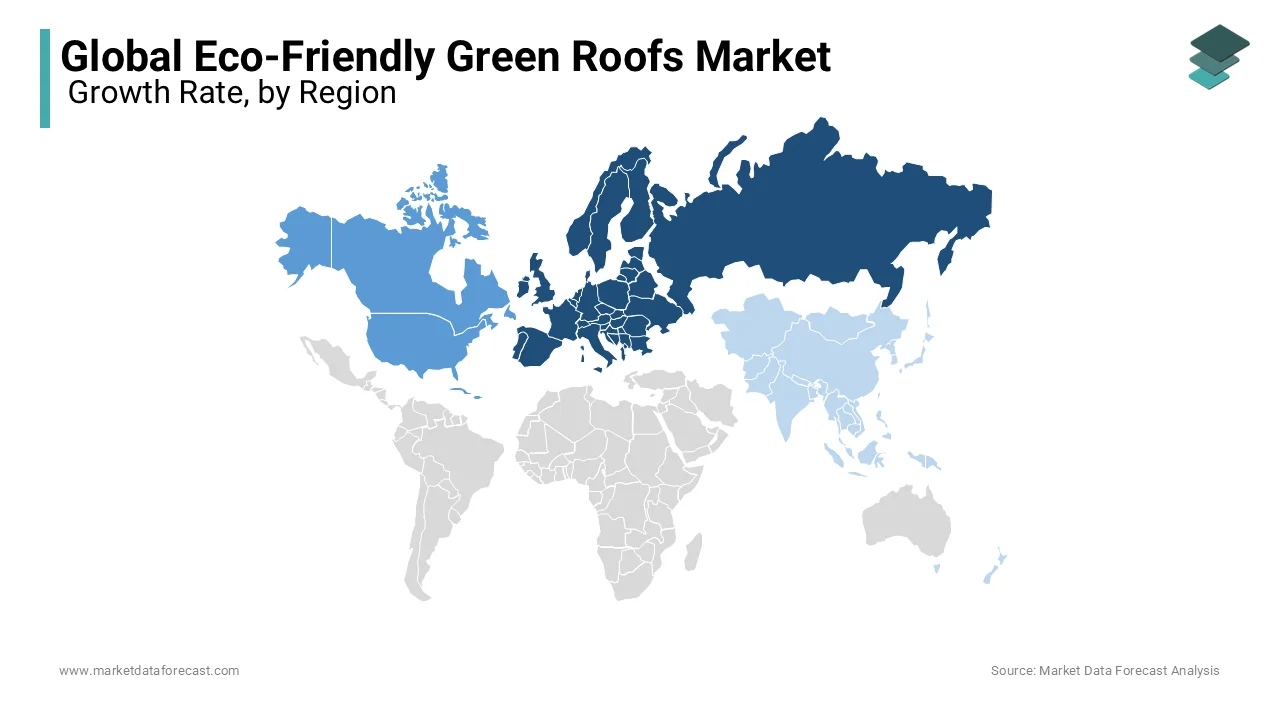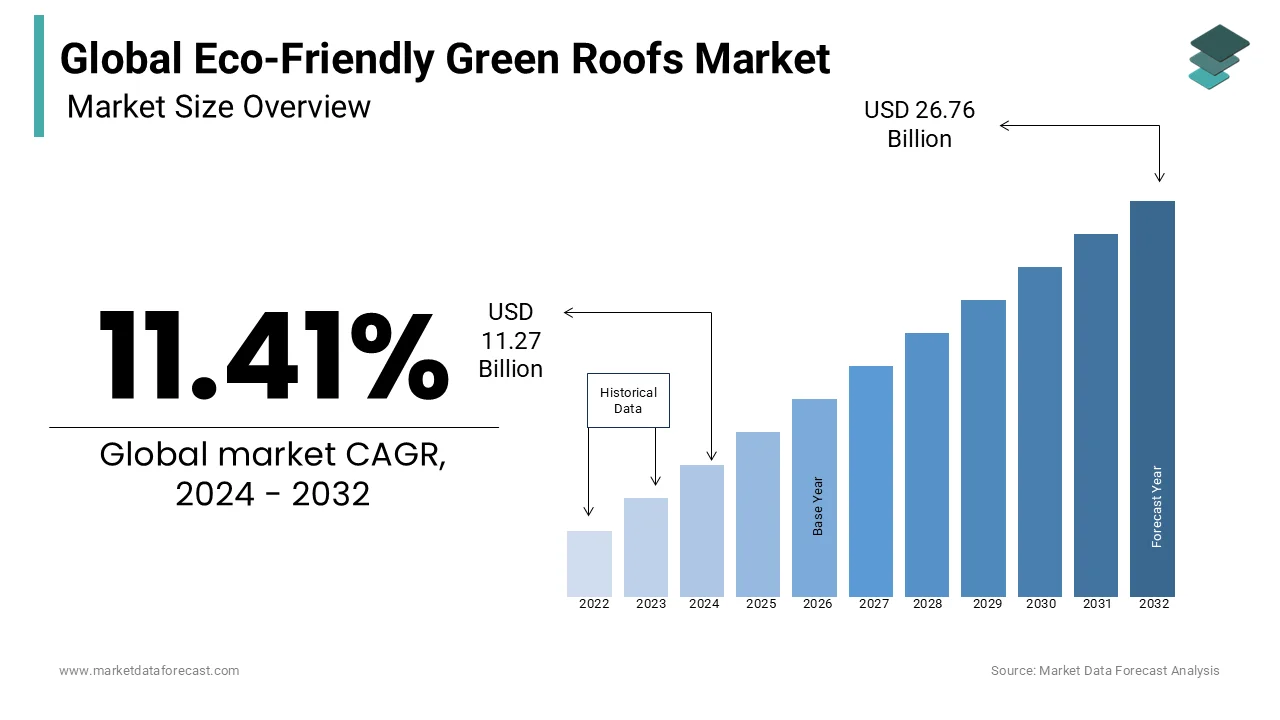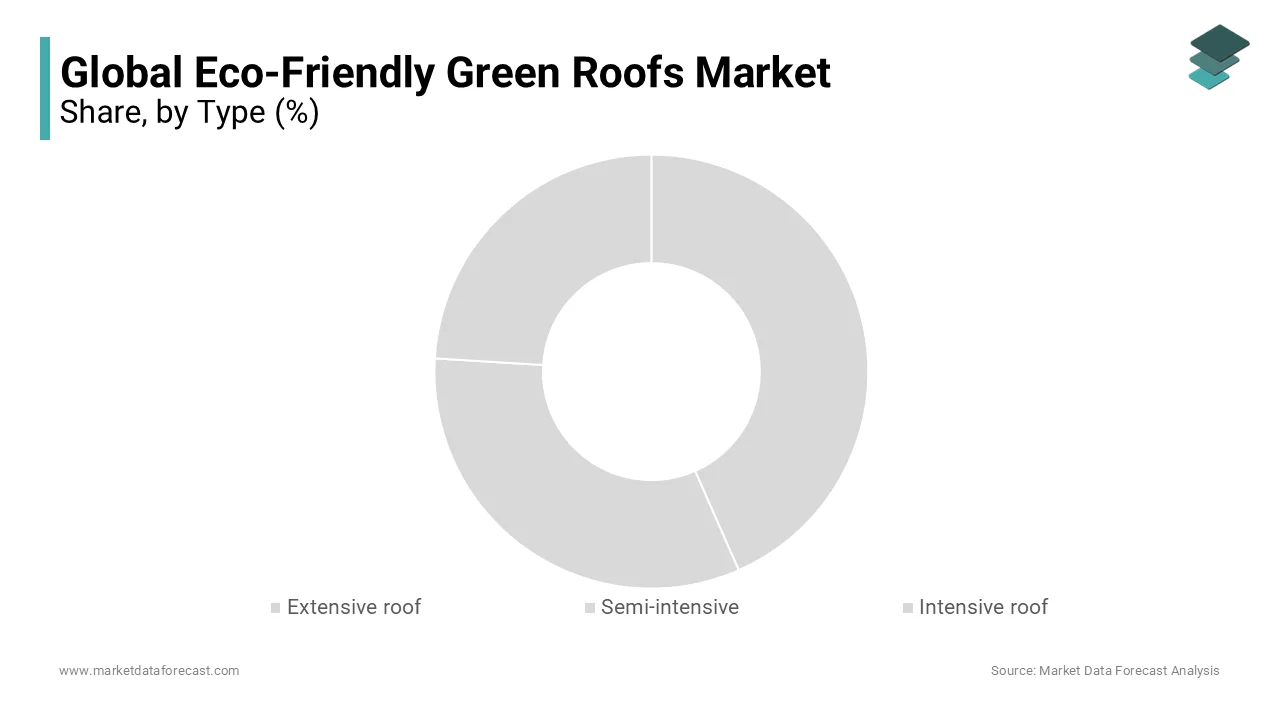Global Eco-Friendly Green Roofs Market Research Report - Segmentation By Type (Extensive Roof, Semi Intensive and Intensive Roof), By End-User (Residential, Industrial and Commercial), and Region - Industry Forecast of 2024 to 2032.
Global Eco-Friendly Green Roofs Market Size (2024-2032):
The size of the global eco-friendly green roofs market was worth USD 10.12 billion in 2023. The global market is anticipated to grow at a CAGR of 11.41% from 2024 to 2032 and be worth USD 26.76 billion by 2032 from USD 11.27 billion in 2024.
Market Overview
The green roof market is likely to be boosted by the worldwide expansion rate contraction of warming due to green roofs. This is achieved by growing plants on roofs that help absorb the sun's radiation and reduce the urban heat island effect. As a result, several governments are implementing supportive policies to encourage the adoption of green roofs. Therefore, the reduction in worldwide warming due to green roofs is expected to drive market expansion during the foreseen period. The green roof is an emerging technology that could offer a wide range of benefits to communities. The installation of an ecological green roof includes the construction of a vegetal layer on top of a house or building. An ecological green roof consists mainly of a layer of vegetation, which includes trees, plants, and shrubs. The main benefits of a green roof are energy reduction, greenhouse gas emissions, better stormwater management, and less heat by regulating roof and adjacent area temperatures.
Market Trends
Green roof construction enables modern social development as well as sustainable development compared to conventional ballasted gravel roofs, contributing to urban heat island problems and water scarcity. The new technology, using natural processes, helps conserve water and reduce solar heat gain. They help reduce the carbon load of buildings, especially in summer, which results in a cooler environment and lower electricity consumption. They also help control greenhouse gas emissions. Thus, its use makes a building ecological and energy efficient. These favourable factors are behind the healthy expansion of the global eco-friendly green roof market.
Market Drivers
The global eco-friendly green roofs market is estimated to grow significantly during the outlook period as these roofs provide thermal insulation, improve air quality and drainage systems, protect the roof and reduce the effect of worldwide warming. Eco-friendly green roofs regulate temperature, provide warmth in the winter, and keep the roof cool in the summer. These desirable properties of green roofs are estimated to drive the worldwide market over the conjecture period. The worldwide market for eco-friendly green roofs is driven by a growing call to adapt to greener methods and resources for the sustainable development of our environment. Rapid urbanization accompanied by a massive increase in carbon emissions and urban congestion has led to the expansion of many environmental problems. Deteriorating air quality and escalating greenhouse effect create a growing call for environmentally friendly technologies like green roofs, further helping the international market.
Market Restraints
The availability of cheaper substitutes is a key factor holding back the market for eco-friendly green roofs. Traditional roofs are inexpensive and easy to maintain compared to these green roofs.
Market Opportunities
Developing countries like China, India, and Singapore have seen tremendous expansion in infrastructure and expansion of the manufacturing sector. These countries offer a significant opportunity for green roof manufacturers, as governments also promote green initiatives to reduce the effects of worldwide warming. Companies around the world are investing heavily in green roof technology, due to the strict rules and regulations adopted by governments to reduce greenhouse gases.
Market Challenges
Green roofs can cause leaks if waterproofing is not done properly. Therefore, inexpensive substitutes are predicted to limit the worldwide nature-friendly green roof market during the forecast period.
REPORT COVERAGE
|
REPORT METRIC |
DETAILS |
|
Market Size Available |
2023 – 2032 |
|
Base Year |
2023 |
|
Forecast Period |
2024 - 2032 |
|
CAGR |
11.41% |
|
Segments Covered |
By Type, End User, and Region. |
|
Various Analyses Covered |
Global, Regional and Country Level Analysis, Segment-Level Analysis, DROC, PESTLE Analysis, Porter’s Five Forces Analysis, Competitive Landscape, Analyst Overview of Investment Opportunities |
|
Regions Covered |
North America, Europe, APAC, Latin America, Middle East & Africa |
|
Market Leaders Profiled |
Optigreen, Tajima, Soprema, Tremco, Sempergreen, Onduline, ZinCo, Kajima, Vegetal, and Vedag, and Others. |
Market Segmentation
Global Eco-Friendly Green Roofs Market Analysis By Type
- Extensive roof
- Semi-intensive
- Intensive roof
The call for extensive roofing is high in the commercial sector; Therefore, it is estimated that the segment will grow at a rapid pace during the foreseen period. Intensive roofs have gained popularity in the commercial and industrial sectors in recent years.
Global Eco-Friendly Green Roofs Market Analysis By End User
- Residential
- Industrial
- Commercial
The commercial segment dominated the eco-friendly green roofs market in 2021. It is projected to grow at a significant CAGR over the foreseen period.
Market Regional Analysis

- North America - the U.S., and Canada.
- Europe - the UK, France, Spain, Germany, Italy, Russia, Sweden, Denmark, Switzerland, Netherlands, Turkey, Czech Republic & Rest of Europe.
- Asia Pacific - India, China, Japan, South Korea, Australia & New Zealand, Thailand, Malaysia, Vietnam, Philippines, Indonesia, Singapore & Rest of APAC.
- Latin America - Brazil, Mexico, Argentina, Chile & Rest of LATAM.
- Middle East & Africa - KSA, UAE, Israel, the rest of GCC countries, South Africa, Ethiopia, Kenya, Egypt, Sudan, and the rest of MEA.
Europe dominated the worldwide market in 2023. It is predicted to maintain its dominance during the foreseen period, due to various policies and subsidies given by governments for the installation of green roofs in the region. Germany is an important market in Europe, as the trend to build an eco-friendly green roof started in Germany in the 1960s. From the 1980s onwards, building codes encouraged the installation of green roofs in several cities in this nation. In Germany, more than 90 million square meters of the product have been installed. Furthermore, in London, the product has gained wide acceptance due to the great influence of the London Plan and accounts for around 42% of all green roofs in the UK. Several private companies have brought some of the latest green roof designs from Europe across the Atlantic to North America, making North America a major emerging market for the industry.
The North American market is supposed to expand rapidly during the estimated period. The US government has adopted strict rules and regulations for the installation of green roofs. In addition, it promotes green roofs by offering a tax credit and reduction, floor area ratio bonus, and financing. For example, in the financing, building owners can receive $ 100 for the installation of each square meter of green roof. The Asia-Pacific is also estimated to be a lucrative market for green roofs during the outlook period. The region's market is predicted to grow at a moderate pace, due to industrialization and urbanization in developing countries such as China, India, Singapore, and Indonesia. Initiatives taken by the Asia-Pacific governments to reduce greenhouse gases are likely to boost the green roof market in the region.
Market Key Players
- Optigreen
- Tajima
- Soprema
- Tremco
- Sempergreen
- Onduline
- ZinCo
- Kajima
- Vegetal
- Vedag
Market Recent Developments
-
Green Roofs for Healthy Cities launches CitiesAlive Virtual 2021. CitiesAlive Virtual 2002 will feature online presentations from experts from some of the world's leading designers and in-person visits to green infrastructure in North American cities.
Frequently Asked Questions
What are the key drivers of growth in the Eco-Friendly Green Roofs Market?
Key growth drivers include increasing awareness of climate change, government incentives for sustainable construction, advancements in green roofing technology, and rising urbanization, which amplifies the need for sustainable urban planning globally.
What are the challenges faced by the Eco-Friendly Green Roofs Market?
Challenges include high initial installation costs, limited awareness in developing regions, technical expertise requirements, and maintenance concerns, which can deter adoption in some markets.
What industries are the primary adopters of green roofs globally?
The construction industry is the largest adopter, particularly in commercial and residential sectors. Additionally, public infrastructure projects, such as schools and hospitals, are increasingly integrating green roofs for their environmental and health benefits.
What are the emerging trends in the Eco-Friendly Green Roofs Market?
Emerging trends include the integration of solar panels with green roofs (biosolar roofs), advancements in modular green roof systems, and the rise of smart green roofs equipped with IoT sensors for real-time monitoring and maintenance optimization globally.
Related Reports
Access the study in MULTIPLE FORMATS
Purchase options starting from $ 2500
Didn’t find what you’re looking for?
TALK TO OUR ANALYST TEAM
Need something within your budget?
NO WORRIES! WE GOT YOU COVERED!
Call us on: +1 888 702 9696 (U.S Toll Free)
Write to us: [email protected]

